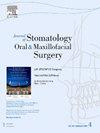全国游离骨瓣植入术调查:主要发现和见解。
IF 2
3区 医学
Q2 DENTISTRY, ORAL SURGERY & MEDICINE
Journal of Stomatology Oral and Maxillofacial Surgery
Pub Date : 2025-02-04
DOI:10.1016/j.jormas.2025.102271
引用次数: 0
摘要
背景:在颈部面部肿瘤学中,重建手术的目的是确保患者生存,恢复口腔面部功能,并保持美观。这些干预措施的最终目标是提供功能康复。然而,无骨皮瓣重建后的牙科康复仍然没有得到充分利用。本研究评估了法国目前的做法,并确定了重建外科医生在肿瘤环境中进行游离骨瓣重建后实施种植体康复所面临的挑战。方法:在法国52家医院进行了一项全国性的调查,以评估与游离骨瓣重建和种植体康复相关的做法。一份在线问卷收集了流行病学、康复实践、团队组织以及增加肿瘤手术后康复患者数量的意愿等方面的数据。结果:19个中心回应,突出了不同的做法。虽然大多数中心每年进行超过20例游离骨瓣重建,但重建后接受植入物的患者数量相对较低,大多数中心在过去一年中报告了1至5例植入手术。种植体康复的主要障碍包括患者照射(61%),缺乏财政支持(61%),缺乏医生网络(50%),培训不足的团队成员(33%),肿瘤复发风险(28%),初次种植手术时间延长(22%),以及由于假影导致的放射随访困难(17%)。尽管具有提高患者生活质量的潜力,但在法国,肿瘤患者的种植牙康复仍然处于边缘地位。本研究强调需要标准化的方案和改进重建外科医生和牙科专家之间的合作,以提高游离骨瓣重建后的康复率。本文章由计算机程序翻译,如有差异,请以英文原文为准。
National survey on implantation practices for free bone flaps: Key findings and insights
Background
In cervico-facial oncology, reconstructive procedures aim to ensure patient survival, restore orofacial functions, and maintain esthetic outcomes. The ultimate goal of these interventions is to provide functional rehabilitation. However, dental rehabilitation following bone-free flap reconstructions remains underutilized. This study evaluates current practices in France and identify the challenges reconstructive surgeons face in implementing dental implant rehabilitation after free bone flap reconstruction in an oncological setting.
Methods
A nationwide survey was conducted across 52 French hospitals to assess practices related to free bone flap reconstructions and dental implant rehabilitation. An online questionnaire collected data on the epidemiology, rehabilitation practices, team organization, and willingness towards increasing the number of rehabilitated patients following oncological surgeries.
Results
Nineteen centers responded, highlighting diverse practices. While most centers perform over 20 free bone flap reconstructions annually, the number of patients receiving implants post-reconstruction was relatively low, with most centers reporting between one and five implant procedures in the past year. Key obstacles to implant rehabilitation included patient irradiation (61 %), lack of financial support (61 %), absence of a practitioner network (50 %), insufficiently trained team members (33 %), risk of oncological recurrence (28 %), extended operating times for primary implantations (22 %), and difficulties with radiological follow-up due to artifacts (17 %)
Conclusion
Despite its potential to enhance patient quality of life, dental implant rehabilitation in oncological patients remains marginal in France. This study highlights the need for standardized protocols and improved collaboration between reconstructive surgeons and dental specialists to increase the rate of rehabilitation following free bone flap reconstructions.
求助全文
通过发布文献求助,成功后即可免费获取论文全文。
去求助
来源期刊

Journal of Stomatology Oral and Maxillofacial Surgery
Surgery, Dentistry, Oral Surgery and Medicine, Otorhinolaryngology and Facial Plastic Surgery
CiteScore
2.30
自引率
9.10%
发文量
0
审稿时长
23 days
 求助内容:
求助内容: 应助结果提醒方式:
应助结果提醒方式:


